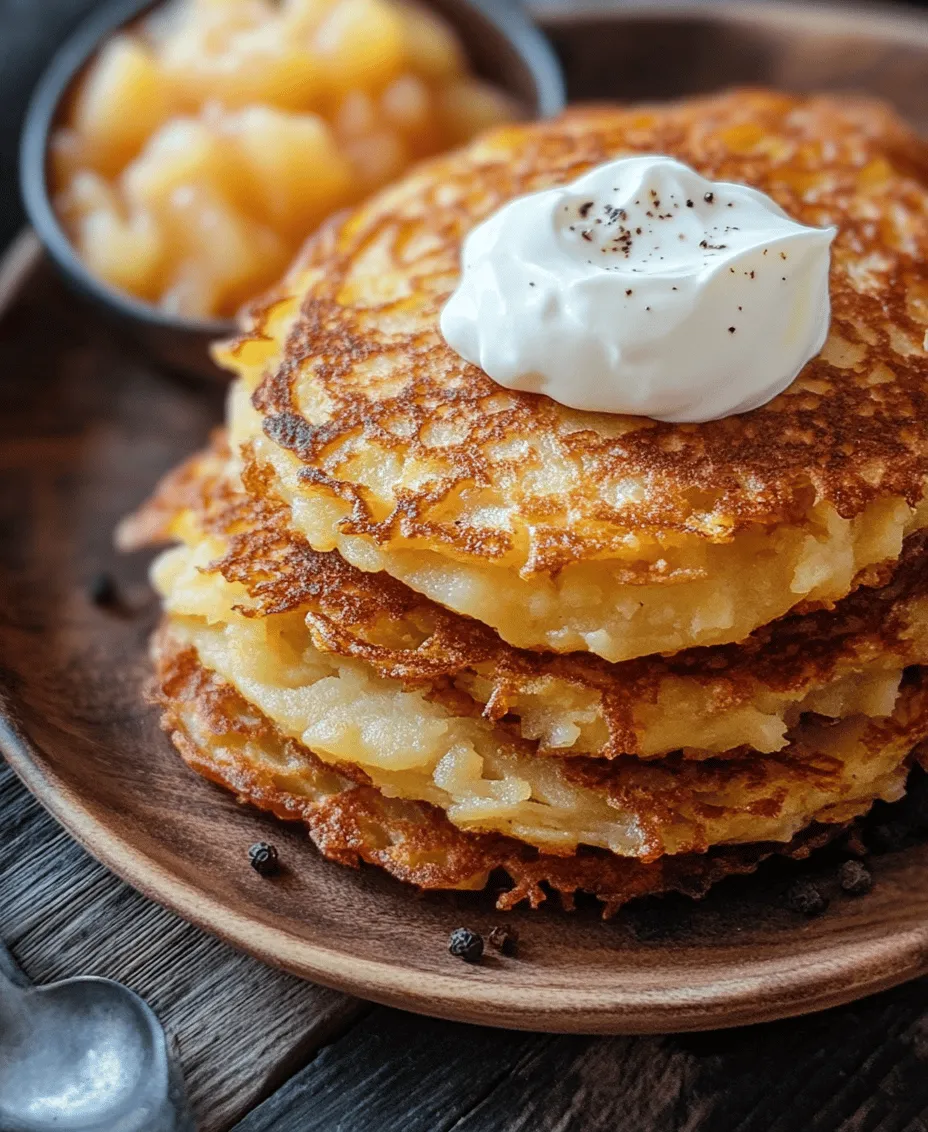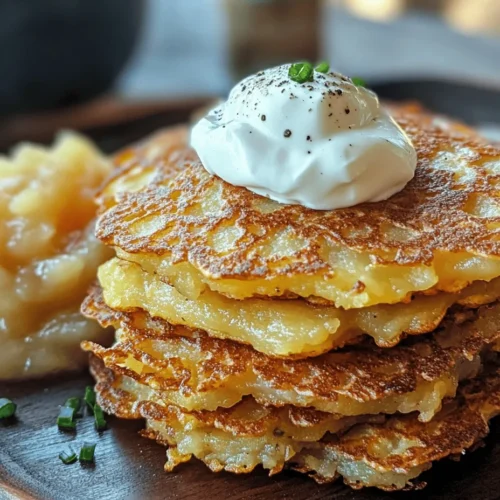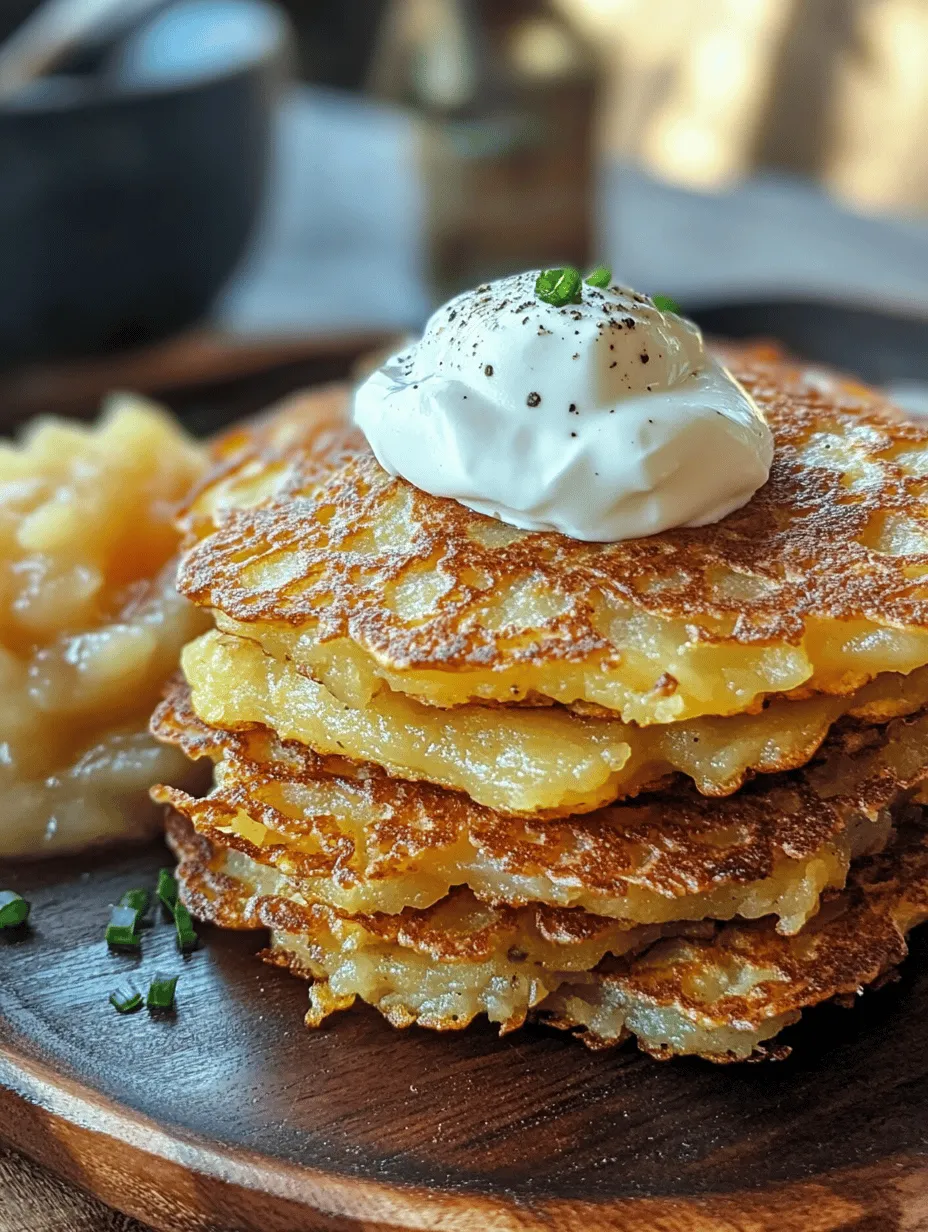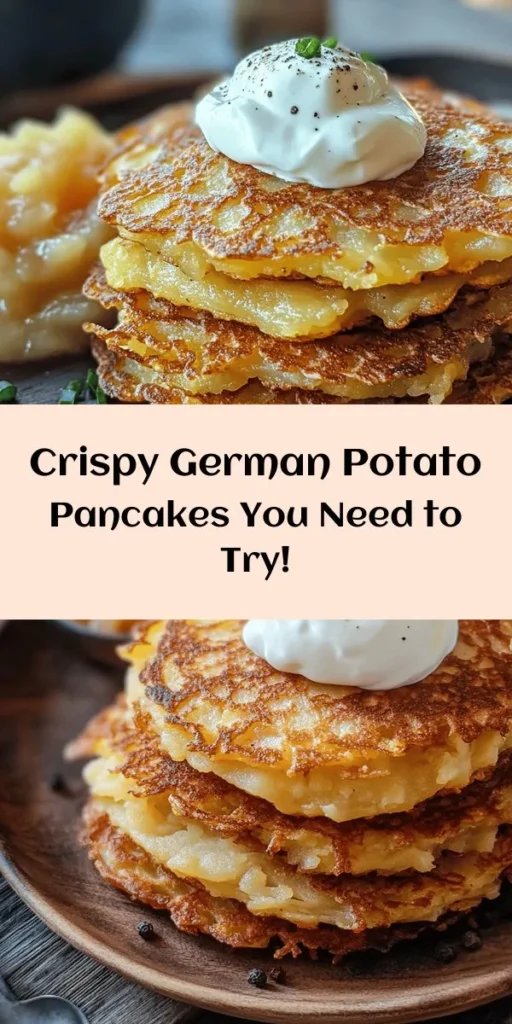Introduction to Authentic German Potato Pancakes (Reibekuchen)
When it comes to the heart of German cuisine, few dishes can evoke the same warmth and nostalgia as Reibekuchen, or German potato pancakes. These crispy, golden-brown delights are much more than just a meal; they embody a cherished tradition that has been passed down through generations. Originating from the rural regions of Germany, Reibekuchen are often enjoyed during harvest festivals and special occasions, where their savory flavor and crunchy texture make them a beloved comfort food.
Reibekuchen hold a special place in the hearts of many German families, often serving as a centerpiece for gatherings and celebrations. The aroma of freshly fried potato pancakes wafting through the air can transport anyone back to their childhood, where family recipes were lovingly prepared in the kitchen. This dish not only satisfies the taste buds but also fosters a sense of togetherness, making it a staple at family dinners and festive events alike.
As we delve into the recipe, you’ll discover that the ingredients are simple yet essential to crafting the perfect Reibekuchen. At its core, the dish relies on the humble potato, which, when combined with a handful of other ingredients, transforms into a delightful treat. The comforting nature of these potato pancakes is further enhanced by their versatility; they can be served as a side dish or enjoyed on their own, paired with traditional accompaniments like applesauce or sour cream.
In this article, we will explore the ingredients that come together to create these authentic German potato pancakes, as well as the detailed preparation steps necessary to achieve crispy, golden perfection. Whether you’re a seasoned cook or a beginner, the joys of making Reibekuchen await you.
Understanding the Ingredients
To create authentic German potato pancakes, it’s crucial to understand the role of each ingredient in the recipe. Let’s take a closer look at the key components that come together to form this delightful dish.
Potatoes
The star ingredient in Reibekuchen is, of course, the potato. While many varieties exist, russet potatoes are typically the best choice for this recipe. Their starchy texture contributes to a crispy exterior while maintaining a soft and fluffy interior. When selecting russet potatoes, look for firm, unblemished specimens. The right potato will not only enhance the flavor but also provide the ideal structure required for the pancakes.
Onion
Onions are a vital ingredient in Reibekuchen, serving to enhance the flavor profile of the pancakes. When grated and mixed into the potato batter, onions impart a subtle sweetness and depth of flavor that complements the earthiness of the potatoes. The choice of onion can also influence the taste; yellow onions are commonly used for their balanced flavor, but you can experiment with sweeter varieties like Vidalia for a different twist.
Eggs
Eggs play a crucial role in binding the ingredients together, ensuring that the pancakes hold their shape during frying. They also contribute a slight richness to the flavor. When preparing Reibekuchen, be sure to use large eggs, as they provide the necessary moisture and protein to create a cohesive batter.
Flour
Flour is another key component that helps to structure the pancakes. It absorbs moisture from the grated potatoes and eggs, creating a thick batter that maintains its form when fried. All-purpose flour is typically used, but you can also experiment with alternatives like gluten-free flour if desired. The right amount of flour is essential; too much can make the pancakes dense, while too little can result in a fragile texture.
Seasonings
While the main ingredients provide the foundation for Reibekuchen, seasonings such as salt, black pepper, and baking powder elevate the flavors to new heights. Salt enhances the natural taste of the potatoes and onions, while black pepper adds a hint of spice. A small amount of baking powder can also be included to introduce a lighter texture, giving the pancakes a bit of lift during cooking.
Vegetable Oil
Choosing the right oil for frying is critical to achieving that coveted crispiness. Vegetable oil is a popular choice due to its high smoke point, which allows the pancakes to fry evenly without burning. Other oils, such as canola or sunflower oil, can also be used, but avoid oils with strong flavors that could overpower the dish.
Serving Suggestions
Traditionally, Reibekuchen are served with a side of applesauce or sour cream. The sweet and tart flavor of applesauce contrasts beautifully with the savory pancakes, while sour cream adds a creamy richness. These accompaniments not only enhance the dish but also allow for personalization, as you can experiment with different toppings according to your preference.
Preparation Steps for Perfect Reibekuchen
Now that we understand the ingredients that contribute to the deliciousness of Reibekuchen, let’s dive into the preparation process. Making these potato pancakes is straightforward, but a few techniques ensure that you achieve optimal texture and flavor.
Peeling and Grating Potatoes
The first step in creating perfect Reibekuchen is peeling and grating the potatoes. Begin by washing the russet potatoes thoroughly to remove any dirt. Once clean, peel them using a vegetable peeler. For the grating process, you can use a box grater or a food processor with a grating attachment. Grating the potatoes finely is essential, as this allows them to cook evenly and develop that signature crispy texture.
Preventing Browning
One of the challenges when working with grated potatoes is their tendency to brown quickly due to oxidation. To prevent this, it’s important to keep the grated potatoes submerged in cold water until you are ready to mix them with the other ingredients. The water helps to slow down the oxidation process and keeps the potatoes looking fresh and appetizing.
Draining Excess Liquid
After grating and soaking the potatoes, it’s crucial to drain excess liquid to achieve crispy pancakes. Once you’re ready to proceed, gather the grated potatoes in a clean kitchen towel or cheesecloth and twist it to squeeze out as much moisture as possible. This step is vital; too much moisture can lead to soggy pancakes that won’t hold their shape during frying.
Mixing the Ingredients
With the grated potatoes ready, it’s time to mix them with the other ingredients. In a large mixing bowl, combine the drained potatoes with grated onions, eggs, and flour. Add salt, black pepper, and baking powder to taste. Use a spatula or wooden spoon to gently fold the ingredients together until well incorporated. The batter should be thick yet cohesive, allowing it to hold its shape when spooned into the frying pan.
Tips on Achieving the Right Consistency for the Batter
To ensure the batter is just right, consider the following tips:
– If the batter feels too dry, add a splash of water or an additional egg to achieve the desired consistency.
– Conversely, if it’s too wet, incorporate a bit more flour to thicken it up.
– The batter should be thick enough to mound on a spoon without falling apart, but still pliable enough to spread slightly when placed in the skillet.
By following these preparation steps, you’re well on your way to crafting authentic German potato pancakes that are crispy on the outside and tender on the inside. In the next sections, we will explore the frying process in detail, as well as some tips for serving these delightful Reibekuchen. Stay tuned as we continue our culinary journey into the heart of German tradition.

Importance of the Skillet Temperature
When it comes to frying authentic German potato pancakes, or Reibekuchen, achieving the right skillet temperature is crucial. The heat of your skillet determines how well the pancakes cook and how crispy they become. Too low, and the pancakes will absorb excess oil and turn soggy; too high, and they can burn on the outside while remaining uncooked on the inside.
To achieve that perfect balance, start by preheating your skillet over medium to medium-high heat. A good way to test if the skillet is ready is to sprinkle a few drops of water onto the surface. If they dance and evaporate almost immediately, your skillet is hot enough. Once you begin frying, adjust the heat as necessary; you want a steady sizzle when the pancakes hit the pan.
The Art of Frying Potato Pancakes
Frying potato pancakes is an art that requires a bit of finesse, but with these detailed frying techniques, you can master the process.
Detailed Frying Technique
1. Prepare Your Skillet: Use a cast-iron skillet or a heavy-bottomed pan to ensure even heat distribution. Add enough oil to cover the bottom of the skillet by about 1/4 inch. Allow the oil to heat until shimmering but not smoking.
2. Spoon Size and Shaping the Pancakes: For uniform cooking, use a 1/4-cup measuring cup or a large spoon to portion out the batter. Gently drop the batter into the skillet, using the back of the spoon to flatten and shape it into a patty. This ensures even cooking and helps the pancakes achieve that desirable crispy edge. Keep the pancakes about 3 inches apart to allow for expansion.
3. Frying in Batches: If you’re making a large batch, it’s important to fry in small batches. This helps maintain the oil temperature; overcrowding can lead to a drop in heat, resulting in greasy pancakes. Fry about three to four pancakes at a time, depending on the size of your skillet.
4. Visual Cues for Flipping: After about 3-4 minutes, check the pancakes for doneness. You’ll know it’s time to flip them when the edges start to look golden brown and the center of the pancake no longer appears wet. Use a spatula to gently lift a pancake and check the underside.
5. Achieving the Perfect Texture: Flip the pancakes carefully and allow them to cook for another 3-4 minutes on the second side. The goal is to have a crispy exterior and a tender, fluffy interior. If you find that the pancakes are browning too quickly, reduce the heat slightly. Conversely, if they aren’t browning at all, increase the heat.
6. Draining Excess Oil: Once cooked, transfer the pancakes to a plate lined with paper towels to absorb any excess oil. This step is vital to maintain the crispiness of the Reibekuchen.
Serving Suggestions for Authentic Flavor
The beauty of Reibekuchen lies not only in its preparation but also in how you choose to serve it. Here are some traditional and delightful serving suggestions to elevate your dining experience.
Traditional Ways to Serve Reibekuchen
In Germany, Reibekuchen is often served hot and freshly fried. The most common accompaniments are applesauce and sour cream, each offering a unique flavor profile that enhances the pancakes.
– Applesauce: The sweetness and tartness of applesauce complement the savory flavor of the potato pancakes beautifully. It’s a classic pairing that brings a touch of nostalgia, often evoking memories of holiday gatherings.
– Sour Cream: For those who prefer a creamy and tangy contrast, sour cream is an excellent choice. It adds richness and balances the crispness of the pancakes with its smooth texture.
Regional Preferences
Different regions in Germany may have varied preferences when it comes to toppings. In some areas, you might find Reibekuchen served with a sprinkling of fresh herbs or chives for an added freshness, while others might include a side of smoked salmon for a more gourmet twist. Feel free to explore these variations to suit your taste.
Pairing Ideas with Side Dishes and Beverages
Reibekuchen can be enjoyed as a main dish or as a side. For a complete meal, consider serving them alongside:
– Fresh Salad: A light green salad dressed with a tangy vinaigrette can provide a refreshing contrast to the rich pancakes.
– Coleslaw: A crunchy coleslaw adds texture and a bit of acidity, which can enhance the overall flavor profile of the meal.
– Beer or Cider: Pairing your Reibekuchen with a crisp lager or a fruity cider can elevate the dining experience. These beverages complement the flavors and enhance the enjoyment of the meal.
Presentation Tips for a Delightful Dining Experience
For a charming presentation, stack the pancakes on a rustic wooden board or a colorful plate. Garnish with fresh herbs like parsley or chives, and serve with small bowls of applesauce and sour cream on the side. This not only adds visual appeal but also allows guests to customize their toppings.
Nutritional Information
Understanding the nutritional content of your Reibekuchen can help you enjoy them as part of a balanced diet. Here’s a breakdown of the nutritional content per serving (2 pancakes):
– Calories: Approximately 250 calories
– Total Fat: 12 grams
– Saturated Fat: 1.5 grams
– Cholesterol: 0 mg
– Sodium: 200 mg
– Total Carbohydrates: 32 grams
– Dietary Fiber: 3 grams
– Sugars: 1 gram
– Protein: 4 grams
Discussion of the Balance of Ingredients and Potential Health Considerations
While Reibekuchen can be a delicious indulgence, they are primarily made from potatoes and can be part of a healthy diet when enjoyed in moderation. Potatoes are a good source of vitamins C and B6, potassium, and dietary fiber. If you’re looking to reduce calories or fat, consider baking the pancakes instead of frying them or using a light spray of cooking oil.
It’s also important to consider portion sizes and the type of accompaniments you choose. Opting for fresh toppings like herbs or a light drizzle of yogurt instead of heavy sauces can make the dish healthier while still retaining its delightful flavors.
Conclusion: The Joy of Making Authentic German Potato Pancakes
The experience of making authentic German potato pancakes, or Reibekuchen, at home is truly rewarding. Not only do you get to enjoy the rich, crispy texture and comforting flavors, but you also connect with a tradition that has been cherished for generations.
As you prepare these pancakes, you might find yourself reminiscing about family gatherings, holiday celebrations, or trips to Germany where the aroma of freshly fried potato pancakes filled the air. This dish embodies comfort and nostalgia, making it a wonderful recipe to share with loved ones.
So, gather your ingredients, fire up the skillet, and indulge in the simple joy of making Reibekuchen. Whether served with applesauce, sour cream, or your favorite sides, these potato pancakes are sure to bring smiles to the table. Share this recipe with family and friends, and create new memories around the delicious tradition of German potato pancakes.



